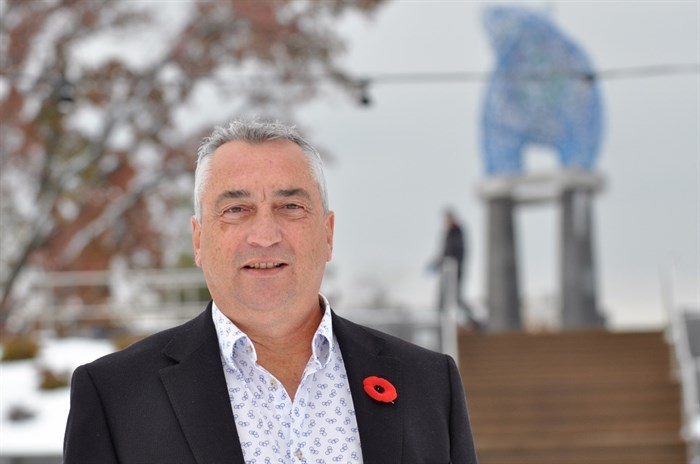
Kelowna's city manager Ron Mattiussi
(JOHN MCDONALD / iNFOnews.ca)
November 23, 2017 - 9:00 PM
When I sit down to interview City of Kelowna CAO Ron Mattiussi about his time as manager of boomtown Kelowna, this is what I know.
I know the long-serving head of the city’s bureaucracy has guided Kelowna's development during a period of unprecedented growth, during its change from a still-largely agricultural tourist town to a small but burgeoning hub city.
I know Mattiussi is retiring soon and Kelowna will be the worse for it.
I also know Mattiussi, who I have interviewed frequently over the years, is likely to tear up.
When he gets talking about something for which he is passionate — and he is very passionate about this city and city planning — his voice will break and his eyes will moisten, a condition he blames on his heritage.
“Sorry, I’m Italian,” is his standard explanation….
SITTING PRETTY
Kelowna is in a demographic sweet spot. It continues as one of the fastest growing census metropolitan areas in Canada. A lot of people want to live here.
Seniors retiring here from other parts of Canada are a mainstay, but house-rich Vancouverites and Albertans in flux keep Kelowna’s real estate market hot.
Construction is everywhere. There’s a highrise going up on Sunset Drive, the first in a decade and the promise of five more in the downtown core. A couple thousand rental units have just begun to hit the market and demand is strong.
A thriving tech and research sector has emerged, centred around UBC Okanagan and the Kelowna International Airport, one of Canada’s fastest growing and busiest airports.
Unemployment is at rock bottom, below five per cent, rents are high and the vacancy rate is below one per cent, not great for renters but its scarcity a sure sign of a city on the move.
Whatever you may think of Mattiussi — he’s had his share of detractors over the years — its hard to argue with the success of the city during his tenure.
On his watch, people have voted with their feet and Kelowna has grown by about 30 per cent to roughly 130,000 people, often leading the province (and sometimes the country) in its pace of development.
Though not without its big-city problems — chronic visible homelessness, a stubbornly high crime rate, increasing traffic congestion, among others — Kelowna is sitting pretty.
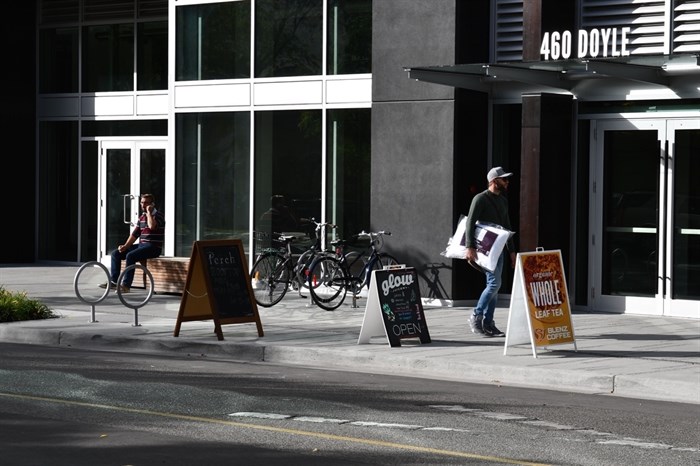
A pedestrian walks by the Okanagan Centre for Innovation on Doyle Avenue.
(JOHN MCDONALD / iNFOnews.ca)
HISTORY LESSON
When I ask Mattiussi if he inherited a planning challenge when he first came to Kelowna, he takes 15 minutes to say yes in the form of a short history lesson. That's another thing I know: I always learn something new from him when we talk.
“It’s hard to judge the past by present standards so it has to be put in context,” Mattiussi says, going all the way back to Kelowna’s forced amalgamation with neighbouring communities and the introduction, or imposition, of the Agricultural Land Reserve in 1973.
Overnight the city became huge, knitting together Rutland, Glenmore and Okanagan Mission with Kelowna, creating a city with a land area almost twice that of Vancouver but with a fraction of the population.
More importantly, Mattiussi says it dramatically shaped the future of a city where 43 per cent of the land base was theoretically off limits to development with another 12 per cent or so undevelopable because of mountain slopes and steep hill sides.
Mattiussi says that in turn, triggered what he terms “leapfrog development by provincial edict” pushing new subdivisions off the orchards and farms on the valley floor and with the blessing of the provincial government, onto the benches and mountain slopes above them.
“Thats why you’ll see as you drive down Lakeshore (Drive), we still have orchards down below and then housing developments above it,” he says, with those neighbourhoods that much harder to service with sewer and transit. "It was not planned, it was leapfrog development.”
Much of this development took place against the backdrop of a decade-long recession, one of the most serious in civic history spanning much of the 1980s, Mattiussi says, painting a bleak picture of a city that at one point had to lay off nearly half its staff.
“There is a reason why the Okanagan was receiving federal development grants,” he says. “The Okanagan was a have-not region, which is why we ended up with Hiram Walker (a distillery) and Western Star (a truck manufacturing plant).”
But by the end of the decade Kelowna had emerged from its prolonged slump.
Mattiussi gives credit to the opening of the Coquihalla and the Okanagan Connector as part of Expo ’86 and the first wave of offshore money fueling a real estate boom in the Lower Mainland.
“All of a sudden Kelowna grew too,” he says. “A lot of people in the Lower Mainland were selling their homes in Richmond or Vancouver for $240,000 and buying one here for $100,000. They were saying I’ll find some kind of job so I can cash out.”
Mattiussi’s own role in the development of Kelowna began in 1995 when he left his position as executive director of the Edmonton Metropolitan Planning Commission for that of director of planning in Kelowna.
The first thing on his to-do list was a critical update of Kelowna's Official Community Plan, a document required by law under B.C.'s then-Local Government Act and one he arrived to find hopelessly out of date.
The second was convincing newly-elected Mayor Walter Gray and his councillors that it was okay to say no to development.
“This was a council that remembered the bad times and it was hard for them to see development as bad,” Mattiussi recalls, of a city he says was ably managed but at a crossroads coming off the recession.
“If you’re overweight and live in North America, too much food is bad, but if you’re living where food is scarce, it’s hard to convince someone a pork chop is their enemy.”
Trying to fight its way out of recession, the city had already made some bold moves, buying up the CN lands and property along the waterfront, stripping off the foreshore rights and selling the land back to developers.
This paid for the development of Waterfront Park, Tugboat Beach and the Rotary Marshes, anchored by the Grand Hotel, Kelowna’s first real waterfront development project.
“Those were the first of the density swap deals where you give us parks and we’ll give you height,” Mattiussi recalls.
The urban centre concept, one that has driven development in Kelowna ever since in places like the Pandosy Town Centre and Rutland, was already in the draft Official Community Plan but Mattiussi convinced them to include a pledge for stronger protection of both the environment and agricultural land.
That also meant reining in leapfrog development, saying no to far-flung subdivision proposals, adding in carriage houses and reversing the ratio of single-family homes to multi-family being built in Kelowna, at the time 75 per cent to 25.
“When I got here and looked at it I said okay, that’s the right approach, now let’s try and get the puck over the goal line,” he says. “You have to remember the idea of protecting the environment and farm land, these were radical changes.”
Mattiussi says changing the mindset of politicians (and taxpayers) meant convincing them that developers would still come even if forced to conform to stricter standards.
“People say the councils of the day were too pro-development," he says. "I don’t think so, I think they were just pragmatic business people from a small town who had lived through some bad times.”
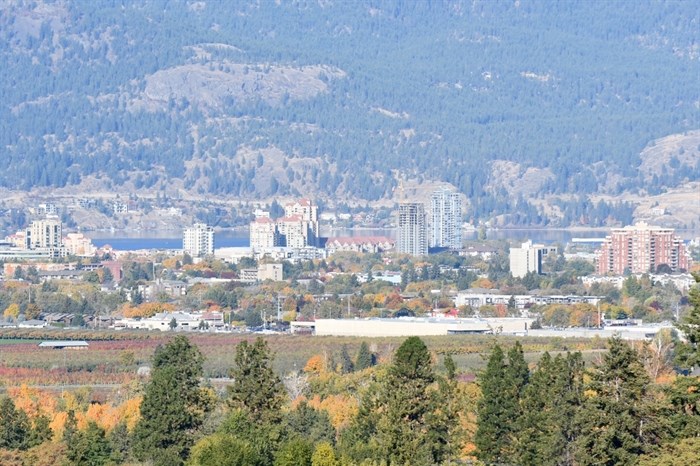
Kelowna's roots as an agricultural town are evident in this photograph taken from East Kelowna.
(JOHN MCDONALD / iNFOnews.ca)
TOP GUN
The role of city manager has often been compared to that of a CEO in charge of a large and varied public company. Most have a shelf life of five years but Mattiussi has worked for four mayors, first as director of planning, then city manager, and has watched a whole bunch of councillors come and go.
Mattiussi says the relationship between professional city planners and the politicians that govern them is by necessity symbiotic — the politicians make the final decisions based on guidance from staff who try to introduce best practices gleaned from local experience but also from communities around the world.
“I think our role is to find ways of listening to the public, to discern what they want,” Mattiussi says. Not down to buying fire trucks or hiring more police officers — those are best left to staff — but in a conceptual sense. He is a great believer in survey research and thinks the questions it asks about perceptions of safety and quality of life are more important than those that simply measure satisfaction with services.
“A better question is ‘do you feel safe?’ and if you don’t we’ll try to figure out a way to make you feel safer,” he adds.
But no matter what, Mattiussi says his job and that of staff is to take the long view, which doesn’t always line up with what citizens may want in the short term.
“Ultimately, I’m the corporate officer here and my job is to make sure this entity called the City of Kelowna is sustainable and keeps moving forward,” he says.
Mattiussi likes analogies and he compares his role to a conductor of an orchestra.
“I don’t play an instrument but I have an orchestra full of amazing musicians. I may have suggestions but the community and council decide on the tune and the conductor interprets that and arranges the score,” he says. “Then I make sure of the rhythm and make sure we get to the end of the song."
Quite naturally, Mattiussi has high praise for his “orchestra," the 600 or so city workers that keep the city functioning
“It’s about hiring great staff,” Mattiussi says. “I would never contend I’m God’s gift to planning but I’m smart enough to hire good staff. I like to think I inspire them to be creative and that mistakes aren’t punished.”
Instead he says he would rather share his vision and then let staff take over.
“I’ve been fortunate to have gifted people around me. So many times they’ve gone out and made something ten times better than I ever could,” Mattiussi says. “If I told them to go out and do this and that as opposed to me saying 'make it special, make it a place where people want to come', it wouldn’t be the same.”
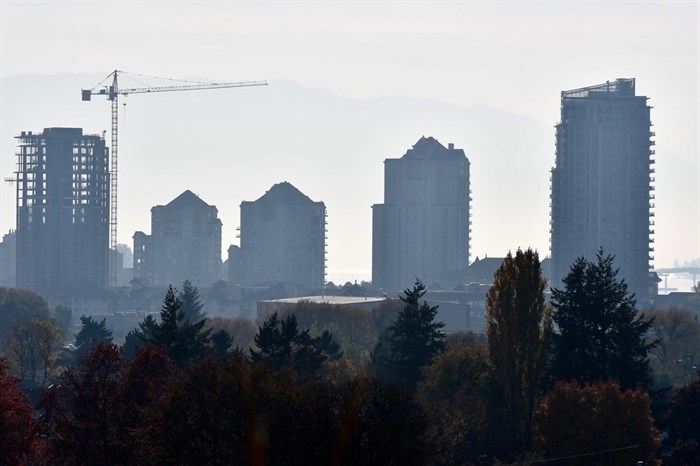
A crane stands beside a building under construction on Kelowna's Sunset Drive.
(JOHN MCDONALD / iNFOnews.ca)
CREATING COMMUNITY
Mattiussi teaches urban planning but has no single mantra or tenet for what guides him, although one phrase keeps cropping up: creating community. He uses it to describe perhaps the biggest change to Kelowna over the last 20 years: the revitalization of Kelowna’s amazingly ordinary downtown core.
“One of the problems with downtown land is a lot of it is owned by people with lots of land here and in other places,” Mattiussi states. “So long as it pays rent, even if it’s cheap rent, there’s very little incentive to redevelop.”
He recalls one of the first public hearings he attended as the newly minted director of planning walking down the city’s main street in May 1995.
“There was one restaurant open, sort of, Arby’s I think. It was a ghost town. Bernard Avenue was a graveyard,” Mattiussi says.
“All I could think of was how can we make this an exciting place. If you build a great urban environment, people will move here and that’s what I think we’ve done,” he adds. "I’m proud of the fact now that it’s November and there’s snow on the ground but there’s still people walking up and down the streets, going to restaurants and doing things. It wasn’t like that when I got here.”
He points to the award-winning Stuart Park and the completion of the waterfront boardwalk as key to connecting the downtown community plus the massive make-over of Bernard Avenue and the introduction of patio culture where the car was once preeminent.
“The streetscape is much more people-oriented and interesting even if you don’t like the light standards,” Mattiussi says, in defence of the main street make-over that some people have dissed. “It’s public art. Your like or dislike of it and the discussion it provokes is sometimes worth it."
One of the biggest pieces of the downtown revitalization puzzle — successful revitalization is always tricky, Mattiussi notes, and is often measured in decades — came together by luck.
“I was literally having coffee with Dr. Rob Halpenny, the CEO of the Interior Health Authority when he mentioned they were looking to consolidate their offices somewhere,” he recalls. “So I said ‘what about downtown’?
The result of that conversation, lucky as it may have been, was the opening in 2016 of the Kelowna Community Health Centre (or the IHA building, as everybody downtown calls it) at the intersection of Ellis Street and Doyle Avenue.
Along with the Okanagan Innovation Centre across the street, the two buildings and the extra thousand employees they bring downtown have turned it into the most urban intersection between Vancouver and Calgary.
“We had tried in the past to get the college or the university to build a campus downtown because in winter, some of these places just board up,” Mattiussi says. “The IHA is the first big employer to come downtown. Obviously it took a lot of work, it was more than just coffee but now downtown can survive the winters. People are actually down here."
There is always some luck to a success story and certainly some fate in the evolution of any community.
For Kelowna, the original floating bridge and the Okanagan Connector connected it to the world, but Mattiussi also points to more recent events such as decisions made under then-premier Gordon Campbell to locate a satellite of the University of British Columbia here and upgrade Kelowna General Hospital into a tertiary hospital centre complete with a medical school.
“Those were huge. There should probably be a statue to him in Kelowna," he says. "Do you know how many well paying jobs that brought in, doctors and nurses and technologists? It was the same with UBC Okanagan and all the professors and researchers it brought to town."
The conversion in 2005 of what was then Okanagan University College’s North Campus into UBC Okanagan has been a particular game changer, Mattiussi says, bringing thousands more young people into town and sparking a small but determined research and tech sector.
“When UBCO was announced, I felt it would have a profound effect on our culture,” he says. “What surprised me was how quickly it did."
You would never get him to call it luck but the 2003 Okanagan Mountain Park fire is when fate handed Mattiussi an assignment that likely cemented his bid for the city manager’s job a couple of years later.
With his boss Ron Born out of reach on vacation, the job of emergency operations director fell to him as acting city manager when the fire broke out, a role that would thrust him in the forefront of the biggest crisis Kelowna has ever faced.
A few days later with flames bearing down on the city, Mattiussi was forced to authorize the emergency evacuation of 30,000 people, many with just a moment’s notice.
The nerves of steel born of that incident surely helped Mattiussi when Kelowna’s now decades-long run of growth was sideswiped in the 2008 recession, just a few years after becoming city manager.
“You know as bad as it was, we really didn’t slow down that much,” he says now. “Our plan didn’t really change and shouldn’t have if we have done our jobs right.”
City planners must by necessity take the long view, Mattussi says, and can really only create the conditions by which a community can succeed.
“Our role is to provide the necessary infrastructure to provide a great quality of life,” he says. “I like to think we enhanced that quality of life with the manmande environment we’ve built around us.”
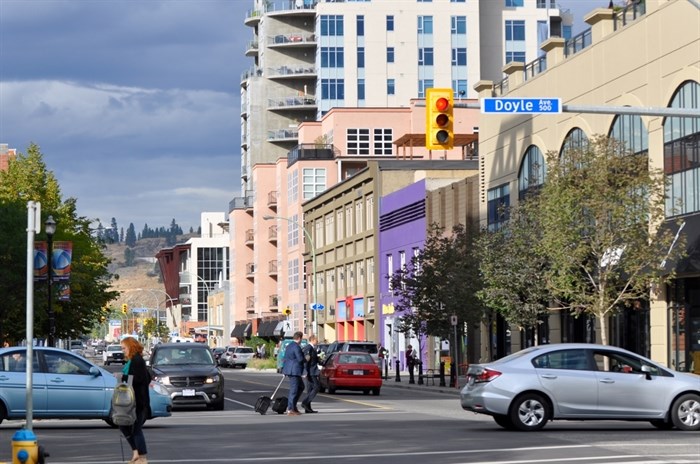
Ellis Street at Doyle Avenue in downtown Kelowna.
(JOHN MCDONALD / iNFOnews.ca)
PUTTING UP HIS FEET
I know Mattiussi has been talking of retirement but it’s still a shock to hear him say he will quit as city manager before the next municipal election in October, 2018.
“It’s a 24/7 job,” he says, in what must be a vast understatement. “It will be nice not to have to worry about everything all the time.”
After so many years worrying about Kelowna so the rest of us don’t have too, Mattiussi is obviously the most qualified person to ask; what should we be worrying about?
Most are obvious — climate change, transportation, housing — others like technological changes and inequality less so but Mattiussi, with his birds-eye view of the city, has the ability to turn these abstract concepts real.
“What could another big flood do to Mission Creek? You drive up to Big White, the banks of the creek are sand, all you would need is one big plug up there and it could create a huge problem downstream.”
Spoken like a man who has been kept awake at night knowing exactly what can go wrong with a city from floods to fires and everything in between. Also spoken like a man who knows he doesn’t necessarily have all the answers and is quite willing to ask.
“Imagine Kelowna (the city’s citizen engagement process) is our attempt to extract as much of that as we can from people. What are the big things we better keep an eye on rather than the old way where you take the current population and extrapolate forward,” Mattiussi says.
The information gleaned from Imagine Kelowna will inform the next big update of the Official Community Plan in 2020.
"Climate change is obviously the big one,” he adds, with this spring’s 1-in-200 year flood still fresh in his mind and now the all-too-common smokey skies during the summer fire season. “There’s a lot of things climate change could do to us."
Some of Kelowna’s problems are more chronic, Mattiussi says, and will require an ongoing community response long after he retires next year.
“Transportation is a tough one. Unfortunately it’s a problem that we can’t fix the way people want us to,” Mattiussi concedes, of Kelowna’s unhealthy car obsession and record as one of the worst per capita transit users in the province.
“They want us to build more lanes and we know more lanes will only generate more cars. We have more cars per capita in Canada, I think, because of the way we live."
Homelessness will continue as an immediate problem, Mattiussi says, as long as people hang out on city streets and other people complain.
“Our only tool legally to deal with street homelessness is bylaw enforcement which is not a great tool to deal with people with mental health issues and drug addictions,” Mattiussi concedes. “But it’s what we bring to the table, we pay for the police too which is not a great solution but you can’t not deal with it."
Homelessness is still part of what Mattiussi says he is most proud: Convincing council and the general public to approve the Cardington Apartments on St. Paul downtown.
Aimed at hard-to-house recovering addicts, it was less than popular with local businesses and homeowners, but one of those times to lead from behind, Mattiussi says.
“Despite anger and fear we stuck to our guns and today people are being helped and the fear-mongering proved baseless,” he says. “That fight paved the way for four more facilities."
Maybe it’s all this talk of disaster, of what could befall the city he so clearly loves that gets him all emotional but when I ask him about his legacy after 23 years, the dam breaks.
“My job has been to transform the city from a town that people had discovered but didn’t really know what to do with and harness that, take the best qualities and turn it into a city, not a big city, but a city with the institutional muscle to make that transformation and to be able to cope with the things that come our way,” Mattiussi says, his voice cracking.
“Sorry, I’m Italian…."
To contact a reporter for this story, email John McDonald or call 250-808-0143 or email the editor. You can also submit photos, videos or news tips to the newsroom and be entered to win a monthly prize draw.
We welcome your comments and opinions on our stories but play nice. We won't censor or delete comments unless they contain off-topic statements or links, unnecessary vulgarity, false facts, spam or obviously fake profiles. If you have any concerns about what you see in comments, email the editor in the link above.
News from © iNFOnews, 2017